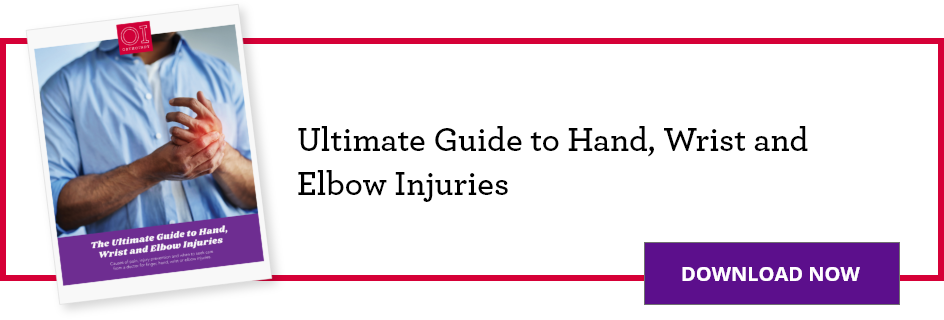THIS POST IS PART OF THE ULTIMATE GUIDE TO HAND, WRIST AND ELBOW INJURIES
Boutonnière deformity is a deformity of the finger that happens when tendons are damaged. It can be a serious condition if left untreated, and can even be permanent.
If it isn’t treated within three weeks of the injury, it becomes difficult to treat and may require surgery.
Find a hand specialist at OrthoIndy
What is boutonnière deformity?
It is an injury to the tendons that help you straighten the middle joint of your finger. The middle joint of the finger will not straighten while the fingertip will bend backward.
There are many tendons that run along the side and top of the finger that help you bend and straighten. The top tendon attaches to the middle bone of the finger and when the top tendon is injured, you cannot fully straighten your finger.

How did boutonnière deformity get its name?
The deformity got its name because the injury causes the bottom bones in the finger to protrude through, similar toa finger through a buttonhole. The french word for buttonhole is boutonniere, which is how it got its name.
What causes finger deformity?
- A forceful blow to the top side of a bent finger at the middle joint
- A cut on the top of the finger, which can cut the central tendon from its attachment to the bone
- Arthritis
- Jamming your finger
Football and basketball are the most common source of sports-related boutonniere deformities.
Symptoms of boutonnière deformity
Signs of the injury can happen immediately or develop over a week to three week time period.
- Unable to bend the finger
- Swelling in the middle joint of the finger
- Pain in the middle joint of the finger
Can a boutonnière deformity be fixed?
You should consult a physician to examine your finger to give you the proper diagnosis and treatment. Your physician will examine the finger and ask you to straighten it out and take X-rays to see if there are any broken bones attached to the central tendon.
There are two different treatment options for boutonniere deformity.
Treatment for boutonnière deformity
Non-surgical
- Splints: A splint will be placed on the middle joint of your finger to help straighten it out. It is recommended that you wear it continuously for about six weeks so it can fully heal.
- Exercises: A physical therapist may give you exercises to help with the strength and flexibility of your finger.
- Protection: If you are active or play a sport you may have to wear a splint or tape it while you participate.
- Oral medications: These can help manage and alleviate pain.
- Injections: These can help eliminate pain and fix the deformity.
Surgical
Surgery is the next step when non-surgical attempts fail or when surgery is the only way to fix the injury. Surgery may be the first option if:
- A large bone fragment is out of position
- A tendon is cut severely
- Deformity which has resulted from rheumatoid arthritis
It generally takes about 12 weeks to recover from these types of surgery. During those 12 weeks, you will have limited use of that hand.
Learn more about hand, wrist and upper extremity care at OrthoIndy
Schedule an appointment
Your well-being is important to us. Click the button below or call us to schedule an appointment with one of our orthopedic specialists. If your injury or condition is recent, you can walk right into one of our OrthoIndy Urgent Care locations for immediate care. For rehabilitation and physical therapy, no referral is needed to see one of our physical therapists.





